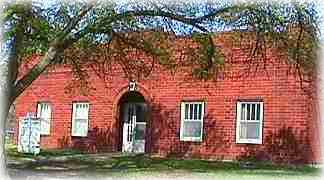
In 1881, the only thing that marked the location of Bushton was a hedge where main street is now located. People started to come to this site and built dug-outs or sod houses. The town was growing and in need of a name. After several suggestions it was finally named Bushton for its dense growth of bushes.
The sod houses took only a few days to build. A ridge pole was put in the center to hold the roof, which was made of logs laid across the rafters, on top. The sod houses were warm in the winter and cool in the summer but very miserable when it rained. This was also a good place for rattlesnakes to hide and they were plentiful.
People survived by eating buffalo, antelope, corn and wheat. Soon the buffalo disappeared but the coyotes, prairie chickens and antelope were plentiful. Everyone raised their own food and the extra produce was taken by team and wagon to Ellsworth, Lyons, or Great Bend to be sold.
Coal was mined one and one-half miles south of Wilson, but it was so dirty it would hardly burn and was very expensive, so most settlers gathered corn stalks and pulled corn stubs to burn. Rags were braided and put in a saucer of grease and then lit for a light. Few people had cows because they were so expensive, but the few in town were confined near the houses by tying ropes to their horns and staking the rope in the ground. A buggy was a sight for sore eyes. Horses were scarce. Grasshoppers were numerous at times and destroyed many crops.
The first settlers were Bill Earl, Ben Beans, and Al Weaver. The Burches, Schoonovers and Tom Haxton settled near Plum Creek. Jim Peterson was the first baby born in the Bushton community. Mount Pleasant was the first school and Wesley Chapel was the first church. The Mangledorf was the first store building in Bushton.
The first car in Bushton was called a Queen and was owned by Mitch Crow. Gasoline was hauled by team and wagon from Ellsworth and sold for 23¢ or 24¢ a gallon. The first frame house built in Bushton was in 1878.
The early settlers for the most part were whole hearted, kind and generous. Having little themselves, they were always ready to serve, assist, or share what little they had with a friend in need. There were no locked doors. The wayfarer was always welcome, even in the small two room houses. People were healthy, as there was little money for doctors. Neighbors would walk to neighbors for long winter evenings. Old and young would join in games such as Charades, Proverbs, and Forfeits. Later years when houses were being built there would be an occasional neighborhood dance. The settlers of the early years despite their hardships were more contented and happy than today's generation. They are a people to be admired.
Adapted from the Bushton Centennial History